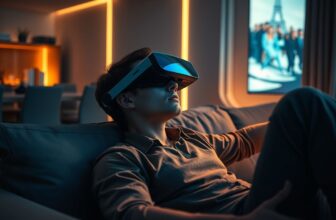Affordable AR glasses are finally becoming a reality, opening up the world of augmented reality to a wider audience. No longer limited to expensive enterprise solutions, several impressive options now exist for under $500. This article explores the best budget-friendly AR glasses available in 2025, helping you navigate the emerging market and find the perfect headset for your needs.
Understanding AR Technology & Key Features
Augmented Reality (AR) is rapidly evolving, offering exciting possibilities for how we interact with the world around us. Unlike Virtual Reality (VR), which completely immerses you in a digital environment, AR *enhances* your existing reality by overlaying computer-generated images onto your view of the real world. Think of Pokémon GO, or filters on social media – these are simple examples of AR in action. Mixed Reality (MR), often considered a step beyond AR, allows digital objects to not only appear in your world but also interact with it, responding to physical surfaces and lighting. Essentially, MR blends the physical and digital worlds more seamlessly than AR.
At the heart of affordable AR glasses lie several key components. The display is arguably the most crucial. Current technologies include optical waveguides, which project images onto a transparent surface, and micro-OLED displays that offer high contrast and brightness within a compact form factor. Processors, similar to those in smartphones, handle the complex computations needed to render AR content and track your environment. Sensors—including cameras and Inertial Measurement Units (IMUs)—are vital for spatial understanding, allowing the glasses to accurately map your surroundings and position digital objects within them. Finally, connectivity via Wi-Fi and Bluetooth facilitates data transfer and interaction with other devices.
Caption: Projected growth of average field of view in AR glasses.
When evaluating AR glasses in 2025, several key features will be paramount. Field of View (FOV) dictates how much of your vision is covered by the AR display; a wider FOV offers greater immersion. Resolution determines the clarity of the projected images—higher resolution is crucial for a sharp and detailed experience. Refresh rate impacts the smoothness of the visuals, minimizing motion blur. Tracking accuracy, often facilitated by Simultaneous Localization and Mapping (SLAM) technology, ensures that the virtual objects remain stable and correctly positioned in your environment. And, of course, battery life will directly affect usability.
However, AR glasses aren’t without their limitations. Current challenges include weight – many devices are still too bulky for extended wear. Heat dissipation is another issue, as powerful processors generate heat that can be uncomfortable. Perhaps the biggest hurdle is the maturity of the software ecosystem. While app development is growing, the availability of compelling AR applications remains relatively limited compared to the smartphone market.
Despite these challenges, the potential applications of AR glasses are vast. Navigation, with turn-by-turn directions overlaid onto your view of the street, is an obvious benefit. Entertainment experiences, from immersive gaming to interactive movie viewing, are rapidly developing. AR can also enhance productivity by providing hands-free access to information and tools. Finally, communication can be revolutionized through AR-powered video calls, allowing for shared virtual spaces and interactive collaboration.
Strengths
- Rapid Hardware Development
- Growing Software Support
- Increasingly Affordable Options
Weaknesses
- Battery Life Limitations
- Weight and Comfort Concerns
- Limited Content Availability
As technology advances and production costs come down, we can expect to see a wider range of affordable AR glasses hitting the market, bringing these exciting capabilities to more consumers. The next generation of these devices promises to address the current limitations and unlock even more transformative applications.
XREAL Air 2: Leading the Pack in Affordable AR
The XREAL Air 2 firmly establishes itself as a frontrunner in the rapidly evolving market of affordable AR glasses. While true standalone AR remains largely in the premium price bracket, XREAL has successfully delivered a compelling augmented reality experience for under $500, focusing on seamless integration with existing devices. These glasses offer a surprisingly refined experience, making them a popular choice for both entertainment and productivity.
XREAL Air 2 Pro Review
- Impressive Display Quality
- Lightweight and Comfortable Design
- Excellent Compatibility
- Relatively Affordable Price
Specifications Breakdown
Let’s delve into the core specifications of the XREAL Air 2. The glasses boast a dual micro-OLED display, delivering a resolution of 1920×1080 per eye. This translates to crisp and vibrant visuals. The field of view (FOV) clocks in at approximately 43 degrees, which, while not the widest available, is respectable for the price point. Weighing in at just 65 grams, they’re remarkably lightweight, ensuring comfort during extended use. Battery life is rated around 3-4 hours for video playback, and connectivity is achieved via USB-C, supporting DisplayPort and power delivery. Bluetooth 5.2 handles audio connections.
Caption: Comparison of Field of View across popular AR/VR headsets.
Strengths and Weaknesses
The XREAL Air 2’s greatest strengths lie in its comfort and ease of use. The lightweight design allows for prolonged wear without significant discomfort, a crucial factor for any AR headset. Compatibility is another key advantage – the glasses effortlessly connect to smartphones, laptops, and gaming consoles via USB-C, broadening their versatility. The display quality is genuinely impressive at this price point, offering vibrant colors and sharp details.
PROS
- Comfortable and Lightweight
- Excellent Display Quality
- Broad Device Compatibility
- Affordable Price
CONS
- Limited Standalone Functionality
- Requires External Device
- FOV Could Be Wider
- Average Audio Quality
However, the XREAL Air 2 isn’t without its drawbacks. Crucially, it’s not a standalone device. It absolutely *requires* a connected smartphone or laptop to function, limiting its usability in situations where you don’t have an external source. The built-in audio, while functional, is somewhat underwhelming, and most users will prefer using headphones. Furthermore, while 43 degrees is decent, the field of view doesn’t offer the immersive experience found in some higher-end AR/VR headsets.
Compared to other affordable AR glasses in the same price bracket, the XREAL Air 2 generally surpasses competitors in terms of overall polish and display quality. While devices like the TCL RayNeo X2 offer more integrated features like cameras, the XREAL Air 2 prioritizes a streamlined and comfortable viewing experience.
User Experiences & Real-World Use
User testimonials consistently praise the XREAL Air 2 for its comfort and ease of setup. Many report using them for extended gaming sessions, watching movies on the go, and even as a portable second monitor. “It’s like having a private cinema anywhere I go!” shared one user on Reddit. Another noted, “I primarily use it for coding while traveling; being able to expand my screen real estate is a game changer.” However, some users have expressed frustration with the dependence on external devices and the limited app ecosystem.
Software and Future Updates
The XREAL ecosystem is centered around the Nebo app, which manages device settings and provides access to streaming services and compatible applications. The app is reasonably intuitive but still lacks the depth and breadth of software found on more established AR platforms. XREAL has consistently released firmware updates to address bugs and improve performance. For 2025, they are focusing on expanding app compatibility and potentially introducing new features like spatial audio support and improved hand tracking through software updates, responding to feedback requests from their user community.
The company is actively working on new and improved versions of the software, and the feedback from the community will play a central role in shaping future updates.
Exploring Alternatives: TCL RayNeo X2 & Rokid Max
Following the impressive showing of the XREAL Air 2, the market for affordable AR glasses continues to expand. While XREAL currently leads the pack, compelling alternatives are emerging, offering different strengths and targeting slightly different user profiles. Two notable contenders are the TCL RayNeo X2 and the Rokid Max. Both aim to deliver immersive augmented reality experiences without breaking the bank, but they achieve this through distinct approaches.
TCL RayNeo X2: A Focus on Visual Fidelity and Computer Vision
The TCL RayNeo X2 distinguishes itself with a strong emphasis on camera quality and potential for computer vision applications. Sporting dual 16MP RGB cameras, it captures detailed imagery, enabling more accurate spatial understanding and object recognition. Specifications include a binocular Micro-OLED display with a resolution of 1920×1080 per eye, a 40° field of view (FOV), and a weight of 81g. It connects via USB-C and supports Wi-Fi 6 for wireless streaming. The RayNeo X2 runs on a Qualcomm Snapdragon 410 platform.
PROS
- Excellent camera quality for AR applications.
- Compact and lightweight design.
- Good display resolution for a clear visual experience.
- Potential for advanced computer vision features.
CONS
- Relatively limited processing power compared to standalone options.
- Requires connection to a smartphone or computer for most functionality.
- Battery life is moderate, around 2-3 hours.
The RayNeo X2’s software ecosystem is built around TCL’s RayWare, offering a growing library of AR apps and tools. It also supports OpenXR, opening doors for developers to create cross-platform AR experiences. Its target audience includes developers, early adopters interested in exploring computer vision applications, and users who prioritize a lightweight and visually sharp AR experience tethered to a powerful external device.
Rokid Max: Standalone Power and Immersive Experiences
In contrast to the RayNeo X2, the Rokid Max prioritizes standalone functionality and processing power. Powered by a Qualcomm Snapdragon XR2 platform, it delivers a more self-contained AR experience, reducing reliance on external devices. The Rokid Max features a binocular Micro-OLED display with a resolution of 1920×1080 per eye and a wider 60° FOV. It also includes six cameras for six degrees of freedom (6DoF) tracking and hand tracking. Weighing in at 210g, it’s noticeably heavier than the RayNeo X2.
Caption: Comparison of Field of View across three popular affordable AR glasses.
The Rokid Max runs on Rokid OS, a custom Android-based operating system optimized for AR applications. It boasts a growing app store with a focus on entertainment, productivity, and gaming. Its target audience includes users who want a truly standalone AR experience, gamers, and those who need the processing power for demanding AR applications. The price point is slightly higher than the RayNeo X2, reflecting its more powerful hardware.
| Feature | TCL RayNeo X2 | Rokid Max |
|---|---|---|
| Processor | Snapdragon 410 | Snapdragon XR2 |
| Standalone | No | Yes |
| Camera Resolution | Dual 16MP | 6 Cameras (for tracking) |
| Weight | 81g | 210g |
| Price (approx.) | $300 | $450 |
Ultimately, the choice between the TCL RayNeo X2, the Rokid Max, and the XREAL Air 2 depends on individual needs and priorities. The XREAL Air 2 excels in comfort and display quality, the RayNeo X2 shines in camera capabilities, and the Rokid Max delivers standalone power and a wider FOV. These affordable AR glasses each offer a unique value proposition within the burgeoning augmented reality landscape.
The market for affordable AR glasses is poised for significant growth in 2025, driven by advancements across several key technological areas. While high-end headsets like the Microsoft HoloLens 2 and Magic Leap 2 command premium prices, a new wave of devices is emerging, aiming to deliver compelling augmented reality experiences at a fraction of the cost. This chapter will explore these future trends and provide guidance on choosing the right set of affordable AR glasses for your needs.
Caption: Projected increase in display resolution for affordable AR glasses.
One of the most crucial areas of development is display technology. Expect to see a shift towards micro-OLED and micro-LED displays, offering higher pixel densities, improved contrast ratios, and wider color gamuts. These advancements will significantly enhance the visual fidelity of AR experiences, making virtual objects appear more realistic and seamlessly integrated with the real world. Coupled with increasing field of view (FOV), these innovations contribute to a more immersive experience.
Processing power is another key factor. New chipsets, specifically those designed for extended reality (XR) applications – like Qualcomm’s Snapdragon XR platform and MediaTek’s Dimensity series – are becoming more efficient and powerful. These chips enable more complex AR applications, improved object recognition, and enhanced spatial understanding. Furthermore, optimized software platforms, such as Android XR Services and OpenXR, are streamlining development and increasing compatibility across different devices. This increased compatibility touches nearly every aspect of the ecosystem.
Battery life remains a significant challenge for AR glasses. However, improvements in battery technology, coupled with the efficiency of newer chipsets, are expected to extend usage times. We’re also likely to see innovative power management techniques, such as dynamic refresh rate adjustment and selective rendering, to conserve energy.
The rollout of 5G and the expansion of edge computing infrastructure will play a crucial role in unlocking the full potential of AR. 5G provides the bandwidth and low latency required for streaming high-resolution AR content and enabling real-time collaborative experiences. Edge computing, by processing data closer to the user, reduces latency even further, resulting in more responsive and immersive AR interactions.
Choosing the Right Affordable AR Glasses
Selecting the best affordable AR glasses depends largely on your intended use case. Here’s a breakdown to guide your decision:
- Gaming: Prioritize glasses with a high refresh rate, wide FOV, and low latency.
- Productivity: Focus on comfort, clarity, and compatibility with productivity apps.
- Entertainment: Consider screen size, resolution, and audio quality.
Budget is, of course, a primary consideration. Set a realistic price range and explore options within that limit. Compatibility with your existing devices (smartphone, computer) is also essential. Many affordable AR glasses rely on tethering to a smartphone or computer for processing power.
| Feature | Tethered AR | Standalone AR |
|---|---|---|
| Processing Power | Relies on external device | Integrated chipset |
| Portability | Less portable | Highly portable |
| Price | Generally lower | Generally higher |
When purchasing, always check the warranty terms and customer support options. A good warranty provides peace of mind, while responsive customer support can be invaluable if you encounter any issues. Look for brands with a proven track record and positive customer reviews. You can find affordable AR glasses on platforms like Amazon, Best Buy, and directly from manufacturers’ websites.
Throughout 2025, expect to see continued price competition, further improvements in display technology, and the emergence of more specialized AR glasses tailored to specific applications. The convergence of these factors will make affordable AR technology even more accessible and compelling, driving broader adoption and innovation.
XREAL Air 2 (Overall)
- Excellent value for money
- Comfortable and lightweight design
- Good image quality
- Limited standalone capabilities
The availability of compelling applications will also be a key differentiator. Developers are actively creating new AR experiences for various industries, from education and healthcare to retail and entertainment. This growing ecosystem of apps will further enhance the value and appeal of affordable AR glasses.
The AR landscape is rapidly evolving, and finding truly affordable AR glasses is now achievable. We’ve explored some of the best options under $500, each offering a unique blend of features and functionality. As technology advances, expect even more compelling choices in the coming years. Explore these options and step into the future of augmented reality today!





